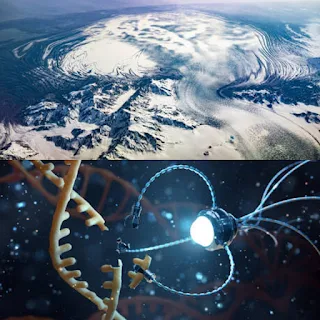NASA has released a three-color satellite image of Alaska's Malaspina Glacier, which makes the massive glacier look like a flaming, rippling blob of paint.
The new image highlights recent discoveries in the glacier, including the 'hidden lake'.
The area of the Malaspina Glacier is about 4,350 square kilometers (1,680 square miles), and it is the largest glacier in North America. Its area covers an area larger than the state of Rhode Island.
Malaspina Glacier is also known as Sít' Tlein, which means "big glacier" in the Tlingit language spoken by the indigenous people of the region.
The image was taken on October 27 by the Operational Land Imager-2, or OLI-2, aboard the Landsat 9 satellite, owned by NASA and the US Geological Survey. It was released by NASA's Earth Observatory on November 25.
The image is a false-color scene created using infrared light. The yellow and orange colors represent ice, while the red color represents water. Blue and green colors show where land and vegetation are located, respectively. The ripples or folds in the ice are moraines (collections of soil, rocks and other debris that are scraped off as the glacier slowly moves forward).
Also visible are the Seward Glacier, which feeds the Malaspina Glacier from the Saint Elias Mountains, and the Agassiz Glacier, which is fed by the same mountain range.
In February, a study published in the Journal of Geophysical Research: Earth Surface revealed that the volume of ice in the Malaspina River had previously been overestimated by about 30%, and studies showed that if the entire glacier melted, it could raise the average surface level. Global sea by 1.4 mm.
The study also revealed that the dark red water spot, located between the ice and a piece of land extending at the end of the glacier, is a salt water lake that was hidden from everyone's sight.
The lake is warmer than scientists previously expected due to its high salt content, which may accelerate the rate of ice melting.
The team also found that there are subglacial water channels running through the rock beneath the glacier. These channels extend up to 35 km (22 miles) under the ice and can accelerate the glacier's retreat.
Developing small biorobots from human cells capable of repairing damaged tissue in the body
Scientists have developed tiny robots using human cells that could one day patrol our bodies, searching for and treating diseased cells and tissues.
These robots, which are assembled from human cells, can repair damage to brain cells in a laboratory dish, according to a recent study published in the journal Advanced Science.
Scientists at Tufts University in Massachusetts have developed microscopic robots to eventually treat diseases. There are several additional steps before that happens, but she expects the technology to repair cell and tissue damage caused by conditions like Alzheimer's.
These robots, called anthrobots, whose name means "human-like robots," are made from human airway cells taken from anonymous donors of different ages and genders.
The team focused on this type of cell because it is relatively easy to access due to work on the coronavirus and lung diseases, and more importantly, because of the feature that scientists believe makes the cells capable of movement.
In the future, if this technology advances to the point that it can be deployed in hospitals, the fact that the robots could be made from a person's own cells, with their own DNA, would help ensure that the body does not reject them, according to lead researcher, Dr. Michael Levine.
Levin, a professor of biology at Tufts University, said there would also be no need for immunosuppressants, the type of medications required after an organ transplant.
To build the robots, Levin and his colleagues started with samples of cells that line human lungs. They then placed them in a petri dish (laboratory dish) and encouraged the cells to grow into clumps. The clumps developed cilia, small hair-like protrusions all around the outside of the cells, which help them move.
Cilia grow naturally in lung cells, which is a big part of why the team chose to use them, added Gizem Gomosskaya, the study's first author who participated in this study during her time as a doctoral candidate in Levin's lab.
In previous work to create cellular structures that do not exist in nature, scientists did this by changing the DNA. But Gomoskaya and Levin didn't want to do that in this study.
“We don't want to create genetically modified organisms,” Gomoskaya said. “If your goal is to take these robots and put them in human bodies, you want as little off-target interference as possible.”
The cytoskeletons were thus created from adult human cells without genetic modifications, making them a potential patient-specific therapeutic tool.
She explained that when you introduce new genes, you increase the chances of the body rejecting them. Instead, they made the cells evolve into a new form just by changing their growth environment.
Clusters of cells were observed moving without any assistance. Next, the team examined whether the robots were able to move over human neurons grown in a laboratory dish that had been 'scratched' to mimic damage, severing connections between neurons.
They then placed the robots in the dish and let them work. They were surprised to see the robots encouraging damaged neurons to grow back, although the team did not yet understand the healing mechanism.




Amazing!
ReplyDelete